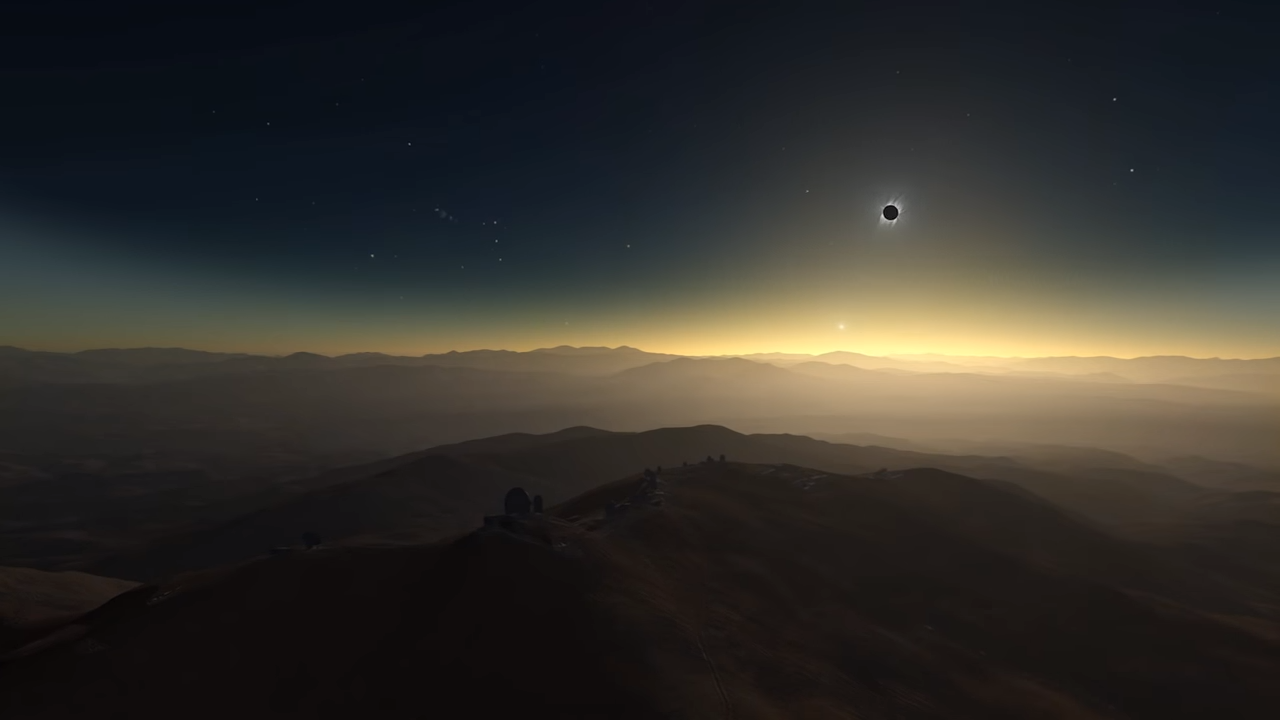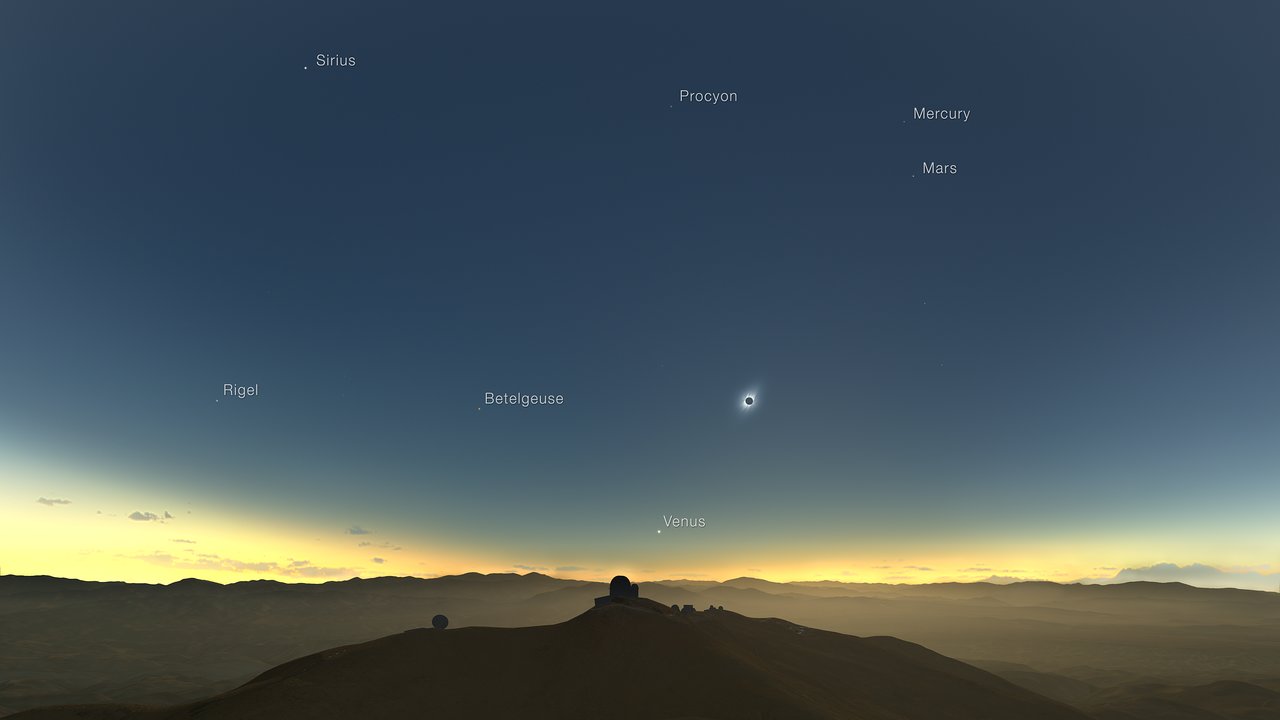What Planets and Stars Will Be Visible During the Total Solar Eclipse?
These celestial objects are not usually visible by day.

If you are planning to experience the total phase of the solar eclipse on July 2, one of the things that you will see when the sun becomes completely hidden is the appearance of stars and planets — in what just moments before had been a daytime sky.
Over the years, I have read a number of observing guides that attempted to describe what the sky looks like during totality. The one description I've seen more often than not goes something like this:
"At totality, the sky darkness resembles the night sky under a bright, full moon."
When I read something like this, I immediately know that the person who wrote those words has never personally experienced a total eclipse. In doing their research, they no doubt discovered that the light of the sun's corona is roughly equivalent in visual intensity to the light of a full moon. So, they arbitrarily think that, because the corona seemingly provides the only source of light in the eclipse-darkened sky, they can draw a similar comparison to a night sky under a full moon.
That, however, is not the case!
Related: Total Solar Eclipse 2019: A Complete Guide
The twilight zone
If we lived on a planet without an atmosphere, then such a comparison would be a viable one. However, our atmosphere plays a role in brightening the sky significantly, even during the darkest stage of total eclipse. To illustrate, it does not get instantly dark at the very moment that the top edge of the sun disappears below the horizon — the effects of twilight keep the sky reasonably bright for 30 or 40 minutes after sunset — and so for the same reason, the sky remains similarly bright during totality.
Get the Space.com Newsletter
Breaking space news, the latest updates on rocket launches, skywatching events and more!
On July 2, the moon's shadow will be a circle of darkness projected on the surface of Earth. If you were situated right in the middle of the shadow's path, out over the South Pacific Ocean, then during the middle of totality, the shadow's outer edge would be at most 62 miles (100 kilometers) away. Beyond that distance, the sun is still shining, albeit as a narrow crescent, and that sunlight would be scattered and bent by refraction into the moon's shadow. In turn, that weakened sunlight would illuminate the sky all around the horizon with an effect somewhat resembling sunrise or sunset.
While there will be a few passenger cruise ships hoping to rendezvous with the moon's shadow over the South Pacific, the vast majority of eclipse watchers plan to congregate near the end of the totality path, in Chile and Argentina. By then, the shadow will be striking Earth's surface at a very oblique angle and will become increasingly stretched out, appearing in the shape of a cigar. Initially, just after totality begins, the darkest part of the sky will be toward the west-northwest — the direction from where the shadow is approaching. The brightest part of the sky will be toward the east-southeast, since it will not yet be enveloped by the shadow. Near the end of totality, the situation will be reversed: The west-northwest sky will rapidly brighten, while the east-southeast sky will appear to be darkest, because the shadow will be rapidly retreating in that direction.
Needless to say, with all of this scattered sunlight being bent into the moon's shadow, you should not expect the sky to get "as dark as a night under a bright full moon." You will not be disappointed, however, for the overall darkness will still be quite striking, and the rapid drop in light levels — to something akin to what you would normally see 30 or 40 minutes before sunrise or after sunset — will certainly be startling (that dropoff in illumination takes only about 30 seconds leading into totality). It simply will not be the same as a moonlit night, however.
But certainly, it will be dark enough for you to see the brighter stars and planets.

What to look for
So what will land-based observers in South America see?
During the upcoming total eclipse, the sun will be in the constellation of Gemini, the Twins. When the sun is totally eclipsed and the sky becomes about as dark as during early-to-mid twilight, Venus is always the most conspicuous object in the sky, but observers have reported seeing other bright planets and some first-magnitude stars as well.
On this upcoming occasion, Venus, shining at magnitude -3.9, will be situated 12 degrees to the lower left of the sun, very low (4 degrees) above the west-northwest horizon. Your clenched fist held at arm's length measures approximately 10 degrees, so Venus will be found just over "one fist's width" to the lower left of the darkened sun.
The next-brightest object will be almost diametrically opposite to Venus and sitting just above the east-southeast horizon: the planet Jupiter, at magnitude -2.6. Two other planets will be shining well to the upper right (roughly 20 to 25 degrees) of the totally eclipsed sun: Mercury and Mars. Mercury will be the brighter of the two, shining at magnitude +1.3. Depending on sky conditions, it "might" be evident to the naked eye. Mars, however, will be shining 4 degrees directly below Mercury at magnitude +1.8, making it a rather challenging object to glimpse visually without the aid of binoculars.
Among the stars, bluish Sirius, the brightest of all (magnitude -1.4) will be glowing about one-third of the way up from the western horizon. And about halfway up in the southwest part of the sky, the yellowish-white star Canopus (magnitude -0.7) — second in brightness only to Sirius — will gleam.
Skywatchers who look about halfway up in the southeast part of the sky will see yellow-orange Alpha Centauri and bluish Beta Centauri, as well as the four stars that comprise the famous Southern Cross (Crux). The two brightest stars, Acrux and Becrux, have a chance of being glimpsed through the totality twilight.
Venus will probably begin to become quite evident to most eclipse watchers a good 10 minutes or more before the onset of totality. As the crescent sun is fading away, Sirius and Jupiter may come into view. During totality, stars that are down to about first magnitude should also be visible. A few fainter stars of second magnitude might appear here and there, but the light of the corona as well as the general scattering of light around the sky will likely squelch the rest of the stars. This eclipse will give you an opportunity to gauge the brightness of the sky, since during totality, we will be able to briefly see the stars and constellations of the opposite season — that is, early January.
Indeed, stretched low across the western and northwestern sky will be the bright stars of Orion, Canis Major and Minor, and Gemini. However, if hazy conditions prevail, the sky background may be quite bright, even at mid-totality. If this holds true, then Venus may be the only object you can see.
A different opinion
George Lovi (1939-1993), who was a longtime popularizer of astronomy and the night sky, once wrote: "One solar eclipse activity I hope to see less of is the sometimes ridiculous efforts to hunt down stars and planets during totality. Some devotees spend virtually all those precious minutes searching! I can't for the life of me imagine how this compares to the main event. And I speak as a lifelong aficionado of observing out-of-season or otherwise 'strange' stars."
I tend to agree with George. While it's fun to watch bright planets and stars suddenly pop into view during totality, you would probably do better to spend a good part of those precious moments concentrating on what George was alluding to as the "main event" (the solar corona). Even those who have detailed experiments planned out in advance sometimes find themselves helpless under the spell of the totally eclipsed sun.
Editor's Note: If you snap an amazing picture of the July 2, 2019 total solar eclipse and would like to share it with Space.com's readers, send your photos, comments, and your name and location to spacephotos@space.com.
- Solar Eclipses: When Is the Next One?
- Things I Used to Observe an Eclipse, Rated
- Swift As the Moon's Shadow: Special Solar Eclipse Flight Planned for July 2019
Joe Rao serves as an instructor and guest lecturer at New York's Hayden Planetarium. He writes about astronomy for Natural History magazine, the Farmers' Almanac and other publications, and he is also an on-camera meteorologist for Verizon FiOS1 News in New York's lower Hudson Valley. Follow us on Twitter @Spacedotcom and on Facebook.
Join our Space Forums to keep talking space on the latest missions, night sky and more! And if you have a news tip, correction or comment, let us know at: community@space.com.

Joe Rao is Space.com's skywatching columnist, as well as a veteran meteorologist and eclipse chaser who also serves as an instructor and guest lecturer at New York's Hayden Planetarium. He writes about astronomy for Natural History magazine, Sky & Telescope and other publications. Joe is an 8-time Emmy-nominated meteorologist who served the Putnam Valley region of New York for over 21 years. You can find him on Twitter and YouTube tracking lunar and solar eclipses, meteor showers and more. To find out Joe's latest project, visit him on Twitter.









